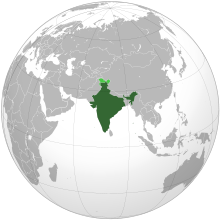India’s Maritime Vision And Its Desire For Great Power Status – OpEd
By Siraj Nizamani
The Indian Navy seeks to enter the new millennium as a professional focused and committed force, extremely conscious of its roles and responsibilities. In times of peace and tension, it is considered a powerful instrument of the nation’s foreign policy, while in times of conflict; it is the foremost expression of the India’s maritime power.
In current strategic scenario, the missions of the IN seem more diverse and complex in contrast to the past. This complexity is global as well as regional, and is unlikely to diminish in the near future. India is adopting rapidly changing maritime domain, similarly, it appreciates these changes and shapes strategies and policies to further national interests. India sees herself as a maritime nation and believes that she has a bright maritime future ahead. They further argue that if India is to fulfill a maritime destiny, the government, the armed forces, the civil services, the media and the public must have a maritime vision and a thorough understanding of the maritime concepts as outlined in the Indian maritime doctrine of 2004.

One of the major inducing force behind this intended rise to a global status is to leave Pakistan trailing behind and tilt strategic balance in South Asia in her own favor. Of course this Indian adventure will leave serious security implications not only for South Asia, but also entire Asia. And this phenomenon has long dominated much of India’s strategic thinking about regional security issues throughout the Indian Ocean. Atal Bihari Vajpayee then Prime Minister of India once directed planners to craft defense strategies that extend beyond South Asia and transcend past sub-regional mind sets.
Simultaneously, Kailash Kumar Kohli, then Commander of the Indian Western Fleet stated, “history has taught India two bitter lessons: firstly, that neglect of maritime power can culminate in a cession of sovereignty, and secondly, that it takes decades to revert to being a considerable maritime power after a period of neglect and decline.” In the recent past Indian power projection in and around the Indian Ocean has been noticeable, and with it the question of how far India is seeking, and succeeding, in making the Indian Ocean to India’s Ocean.
In its own words Kalash further elaborates that, “it is vital, not just for India’s security but also for her continued prosperity, that we possess a Navy which will protect the nation’s vast and varied maritime interests, where the Navy’s role is to help maintain peace in the Indian Ocean, meet the expectations of our friends and neighbors in times of need, and underpin India’s status as a regional power.” Former Indian naval chief Arun Prakash also says “as the preeminent maritime power in the Indian Ocean, we must possess and maintain a capability for sustained operations in our area of interest. The strategic end is to be the pre- eminent maritime power in the Indian Ocean, and the “means” to bring about this end is a strong navy that can maintain a capability for sustained operations in and throughout the Indian Ocean.”
India believes that her position is pivotal in the Indian Ocean Region. And sees her as the only viable link between the various maritime zones of the Indian Ocean region, i.e. between the Malacca Straits, Andaman Sea, Bay of Bengal, Central Indian Ocean, Arabian Sea and its extensions in the Gulf and Red Sea. As Krishna Pant concludes” the mainland Indian peninsula, surrounded by the Arabian Sea and the Bay of Bengal, thrusts deep into the Indian Ocean.”
India perceives this position as unique to face in both directions, and simultaneously seeks to s control the Arabian Sea to the west and the Bay of Bengal to the east, as well as to look southwards deep into the Indian Ocean.
India also has over 1000 islands and atolls, accounting for over 1300 miles of additional coastline. Under the Law of the Sea, India’s huge coastline gives her an equally huge Exclusive Economic Zone, EEZ, of around 1.37 million square miles, around 95 percent of India’s external trade passes through the sea. With its over 1 billion populations, India has undeniable dreams and hopes of Great Power status for the 21st century.
Especially after detonation of nuclear devices in 1998 India has been bearing in mind herself as a major global player, or at least a major Asian power, and it has been deeply frustrated for not being respected as a prominent actor on the international and Asian scene. Major policy decisions, such as overtly going to nuclear, can be attributed to this eternal desire to be seen as a great power. For years both Indian and foreign analysts have expected that by the early 21st century India would become a major projector of power and influence throughout Asia. Indeed, the most recent evidence suggests that the Indian government has now opted for a 20-year program to fulfill that goal and become a major military power with influence spreading across the Indian Ocean, the Arabian Gulf and the four corners of Asia.
Siraj Nizamani currently teaches in International Relations Department at University of Sindh, Jamshoro, Pakistan. His areas of interests are: Security issues in South Asia and Indian Ocean region, China’s Strategic policy, nuclear proliferation and Terrorism. Mr. Nizamani is a regular writer of different newspapers and weekly magazines. He holds M.Phil degree in Defence and Strategic Studies from Quaid i Azam University, Islamabad. The author can be reached at [email protected]
